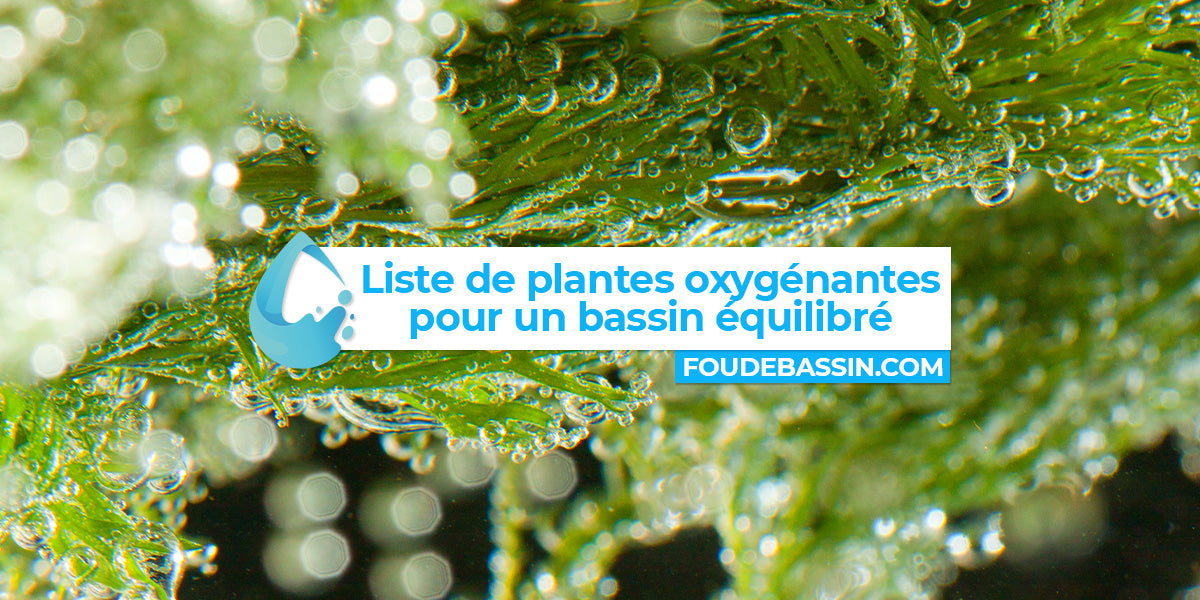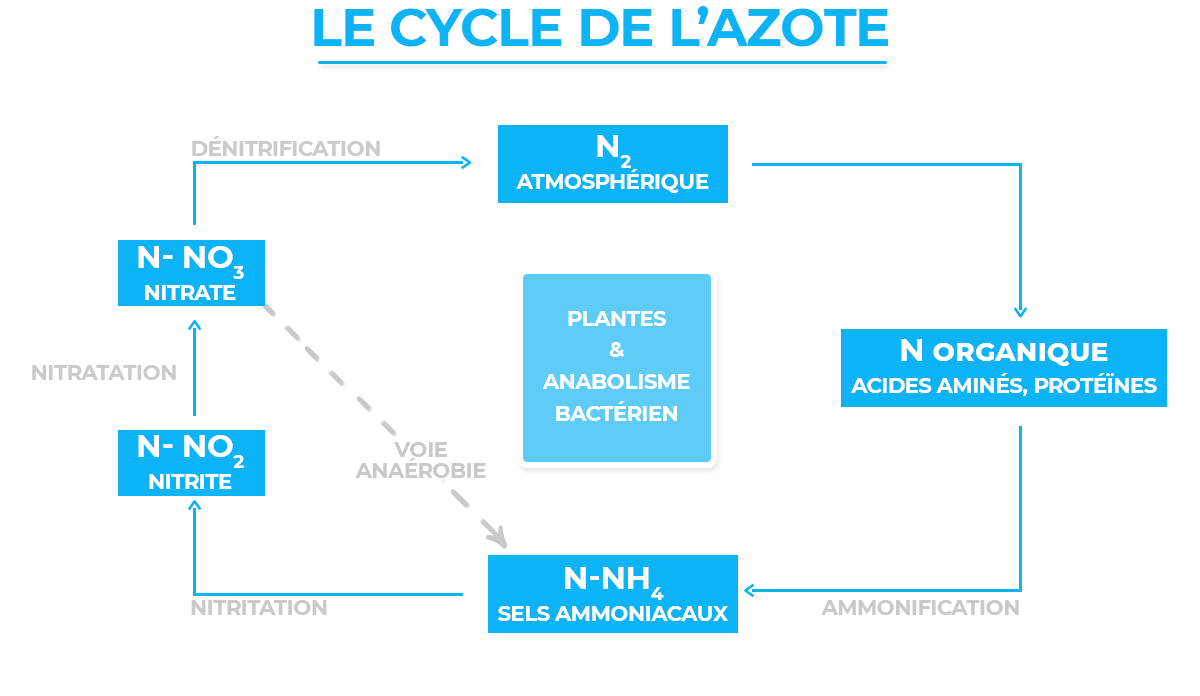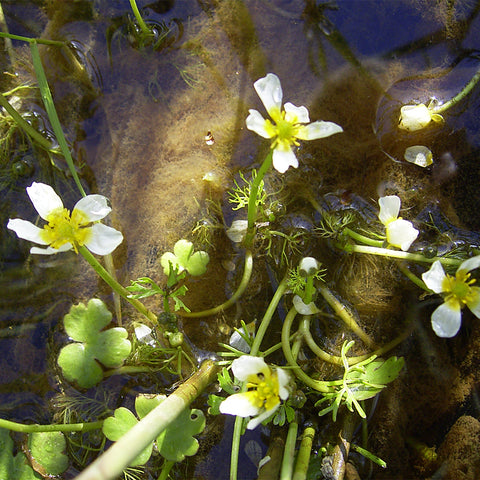Retrouvez ici les indispensables et meilleures ventes pour nos propriétaires de bassin.
Retrouvez ici les indispensables et meilleures ventes pour nos propriétaires de bassin.

Are you looking for a list of oxygenating plants that live in water, to have a balanced pond? If so, do you know how to find oxygenating plants and where to order them? Today, we explain why and how to put oxygenating plants in your pond.
As you can imagine, these aquatic plants grow below the water level, or below the surface. These plants are called such because they release oxygen into the pond or pond water. Of course, this oxygen supply is vital for the fish.
In short, the answer is yes . Oxygenating plants are literally essential if you have a garden pond or pond. As we noted earlier, they grow below the water level, and are absolutely necessary to maintain the proper balance of the pond.
On the other hand, they greatly contribute to improving and optimizing the nitrogen cycle. In other words, they contribute to the purification of basin water. This by assimilating excess organic matter from it.
Aquatic plants perform a doubly important role in the pond ecosystem. They therefore take care of producing oxygen, while absorbing impurities from the pool. This last function helps to keep the pond clear and clean.
Finally, most of these aquatic plants filter the water , and limit the spread of unwanted algae. In this case, they do so by competing with them in terms of nutrient consumption.
It may interest you: we have an article that explains how to kill algae in a pond or pond.
In the context of a basin or a pond, the nitrogen cycle is an important parameter to consider. It is a cycle describing the different stages and modifications undergone by nitrogen, in its different forms. In this case: organic nitrogen, nitrates, nitrites, ammonia and dinitrogen. In other words, plants with filtering capacities are responsible for assimilating the excess organic matter in a pond.

During this nitrogen cycle, pond water will be toxic to fish. It is during this period that ammonia from the soil is transformed into nitrites, before degrading into nitrates. This is where plants come in, assimilating nitrates and producing oxygen. Finally, the nitrogen cycle is one of the aspects to consider before putting fish in a new tank .
Plants produce oxygen through the reaction known as photosynthesis. What is photosynthesis ? To illustrate it more simply, let's go back to the school benches for a moment and rediscover what this phenomenon is.

In a simplified way, photosynthesis consists of synthesizing organic matter from soil water and carbon dioxide from the air. This procedure uses energy provided by the sun and takes place in cells that contain chlorophyll . It will result in the production of oxygen, and the rejection of it into the atmosphere.
In the case of a basin or pond, it is therefore the use of solar energy to synthesize carbohydrates and release oxygen into the water.
Oxygenating plants bring together a range of interesting and effective advantages at the same time. It is therefore normal that they are very popular in the world of basins and ponds. And for good reason, they play a major role in the balance of this type of ecosystem.
As much for aesthetics as for practice, oxygenating plants are practically essential when you have a pond. Below is a non-exhaustive list of what aquatic plants bring to a water point.
In summary, these fully or partially submerged plants produce oxygen during the day. At the same time, they provide a natural shelter for aquatic life. This particularly concerns newts, fry and other amphibians.
Oxygenating plants are vital for maintaining the balance of a garden pond or pond. That said, too many oxygenating plants are not healthy for the pond. It is therefore advisable to check the development of these several times a year.
When necessary, do not hesitate to remove them. In this case, many oxygenating plants are famous for their high speed of proliferation. It will also be necessary to remember that, at night, they will consume oxygen.
As a result, it is necessary to avoid that more than 50% of the surface of the pool is covered with oxygenating plants. For better orientation, you can consult our article which explains how to analyze the water of the pond .
To facilitate your choice of oxygenating plants, we advise you to choose from the native plants listed below. They are all fairly easy to plant, and are a very good start in setting up a pond.
Waterweeds are floating and completely submerged aquatic plants, very popular for decorating aquariums. More specifically, waterweed is a member of the family Hydrocharitaceae . It is also known as the "water plague" .

This oxygenating plant is native to North America, and is widely used in phytopurification. It can be very invasive, but will also provide valuable shelter for fry and other aquatic invertebrates.
Characteristic of fresh water points, callitriches are part of the Callitrichaceae family. It is an aquatic plant that is found on the surface of the water, just as it can be found in immersion.

Among the most common, the marsh callitrich is known for its oxygenating properties. In addition, it can be used as a shelter to accommodate the spawning of egg-laying fish. Like some oxygenating plants, callitrich can be persistent. It can even become particularly invasive in the sun.
Bushy and feathery in appearance, the Ceratophyllum demersum is known by its nickname: Submerged Cornifle . It is a plant almost totally devoid of roots, and very popular in aquariums. Permanently submerged, the Submerged Cornifle gives the impression of floating in water.
This aquatic plant feeds on the same nutrients as algae, which is very effective in preventing the development of these. In terms of maintenance, leave the stems dark in color. On the other hand, you can remove the stems of yellow or light color.

The submerged hornwort is appreciated by aquarists and amateur gardeners, especially for its resistance. Easy to care for and not very prone to diseases, this aquatic plant will settle without worry in water points.
The water violet or Hottonia Palustris is known by many nicknames. Thus, some will know it as the Hottonia of the marshes or even the Yarrow of water . It is an aquatic plant that likes to grow in ponds and forest ponds.
Marsh Hottonia is an excellent plant for oxygenating the garden pond, with pinkish-purple primrose flowers appearing above the water from May to June.

For its part, this plant is quite demanding. It therefore prefers calm, cool and non-calcareous waters. Finally, a depth of 60 cm is needed for the water violet to develop properly.
The Hippuris vulgaris plant is known more commonly as the water pesse . It is an anti-polluting plant, belonging to the Plantaginaceae family and found in North America, Asia and Europe. In some regions, it is also called the “Oxygenating Horsetail” .

Highly valued in phytopurification, water pesse is an oxygenating plant that absorbs nitrates and phosphates. At the same time, it constitutes a refuge very suitable for aquatic fauna.
Similar to Java moss, Fontinalis antipyretica is often found on the banks of streams and rivers. Resistant and undemanding, it is also known as the Moss of the fountains or common fontinal .

Fontinalis antipyretica is a very resistant oxygenating foam. It can dry in the sun, and regain all its greenery as soon as it is immersed. At the same time, it provides shelter for insect fry and larvae during breeding periods.
Eurasian watermilfoil , or Myriophyllum spicatum , is an aquatic plant with long, floating stems. It is a plant with English origins that has bushy and feathery olive green foliage. Small yellow and red flowers appear above the surface of the water between May and August.

The ideal is to provide a minimum depth of 30 cm of water to accommodate them. At most, we prefer a depth of 90 cm. Finally, it should not be confused with other watermilfoils that are not native, such as Myriophyllum verticillatum .
Potamogeton or Potamots are aquatic plants whose flowers are grouped in spikes. Their leaves are partly submerged and partly floating. The Potamogetonaceae family has members known for their filtering properties

Among others, the Curly Pondweed or Potamogeton crispus is an oxygenating submerged plant. It has the particularity of growing quickly, and quite easily. Pondweeds often serve as hiding places and shelters for the surrounding aquatic fauna.
From its scientific name Ranunculus aquatilis , this aquatic plant is known by many nicknames. Thus, it is called the Froglet , the water buttercup or even the aquatic buttercup .

Capable of growing both underwater and on the surface, this oxygenating plant is found in ponds and slow-flowing waterways. In terms of oxygenation, it is often considered to be more interesting than Canada waterweed .
Quite atypical in their appearance, arrowheads are these aquatic plants, which are also known as arrowheads. Also called water arrows, they are characterized by filtering and oxygenating properties.

More particularly, Sagittaria latifolia are plants known for their resistance. In this case, they can withstand salinity just like wastewater. In addition to being decorative, the water arrow can adapt to fluctuations in water level.
These aquatic plants are more commonly called Vallisneria spiralis , or spiral vallisneria . The meadows they form are generally rich in biodiversity, and are characterized by a high oxygenation potential.

Spiral vallisneria is often found in aquariums as well as in ponds. Nevertheless, its rapid growth must be taken into account.
The answer is quite short, it's no 🙂 Plants do produce oxygen throughout the day, but they consume it during the night. It is for this reason that we recommend using an air pump, in addition to oxygenating plants.
This alternative will allow you to oxygenate your water point well, without compromising its health. The idea being to optimize the oxygen supply to the pool: the combined use of an aerator and oxygenating plants provides abundant dissolved oxygen.
At the same time, this solution will provide habitat and hiding places for snails, fish and other waterhole inhabitants.
This small file therefore gives you a fairly large list of oxygenating plants for your pond. The most important thing will be to regularly check the different parameters of the water and the pool. This will help you maintain them more easily, and more efficiently.
Don't forget to consider the best times to plant in an aquatic environment . This will be practical in determining the needs and necessities of the pond.
If you have any questions, do not hesitate to contact us! Our team will be happy to accompany you and guide you! You can also leave us a comment, we will be happy to answer you 🤗
Finally, we end this list with a selection of oxygenating plants and practical accessories for ponds.
Aquipond Greenstab - Natural treatment against pond algae It is a natural product that helps limit algae at any time. It also has a prevent...
View full detailsReduces the layer of silt in the pond by at least 40% Easy to use with less impact on biodiversity Prevents fermentation, bad odors. pH ...
View full detailsOrganic dye to block plant growth by limiting photosynthesis ORGANIC PRODUCT NON TOXIC TO HUMANS (DIVING) AND FISH. 100% NATURAL AND BIODE...
View full detailsThe positive effects of barley straw have been known to water enthusiasts for a long time. But currently barley straw is difficult to find and i...
View full detailsReduces at least 40% of the layer of silt in the pond Easy to use with less impact on biodiversity Prevents fermentation, bad odors. ...
View full details
Comments
Leave a comment